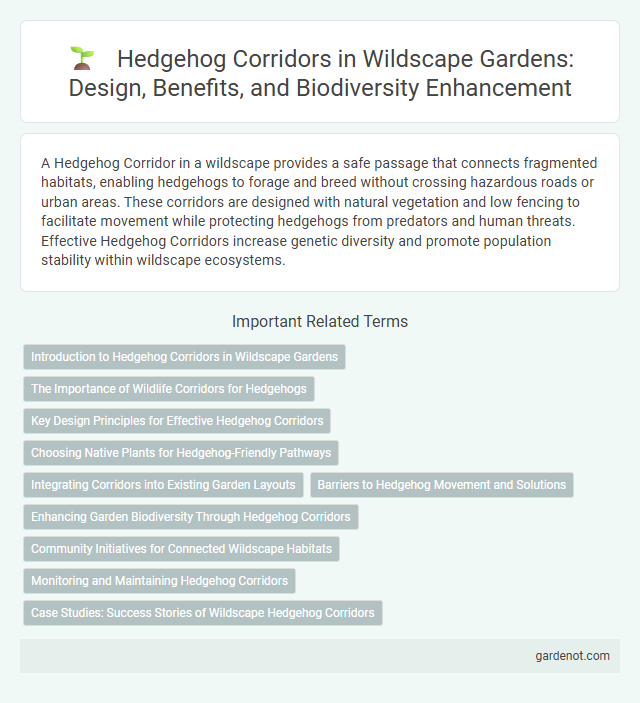A Hedgehog Corridor in a wildscape provides a safe passage that connects fragmented habitats, enabling hedgehogs to forage and breed without crossing hazardous roads or urban areas. These corridors are designed with natural vegetation and low fencing to facilitate movement while protecting hedgehogs from predators and human threats. Effective Hedgehog Corridors increase genetic diversity and promote population stability within wildscape ecosystems.
Introduction to Hedgehog Corridors in Wildscape Gardens
Hedgehog corridors in Wildscape Gardens create safe passageways connecting fragmented habitats, enabling hedgehogs to forage and breed without crossing roads or facing predators. These corridors use natural vegetation and specially designed gaps in fences to maintain connectivity, promoting biodiversity and supporting local hedgehog populations. Implementing hedgehog corridors significantly increases survival rates and habitat accessibility within urban and suburban garden landscapes.
The Importance of Wildlife Corridors for Hedgehogs
Wildlife corridors are essential for hedgehogs, providing safe passages that connect fragmented habitats and reduce road mortality risks. These corridors support genetic diversity by allowing hedgehogs to access new territories for foraging and mating, which is crucial for their population resilience. Maintaining and enhancing hedgehog corridors helps mitigate the impacts of urbanization and habitat loss, promoting long-term species survival.
Key Design Principles for Effective Hedgehog Corridors
Effective hedgehog corridors prioritize continuous, connected habitats with minimum gaps to ensure safe passage and reduce road mortality. Incorporating natural ground cover like leaf litter and dense underbrush provides necessary shelter and foraging opportunities. Strategic placement near hedgehog activity zones and minimizing light pollution enhances usage and supports population stability.
Choosing Native Plants for Hedgehog-Friendly Pathways
Selecting native plants such as hawthorn, bramble, and dog rose creates dense, thorny hedgerows that offer shelter and foraging opportunities, enhancing hedgehog corridors. These species attract invertebrates like beetles and worms, which constitute essential food sources for hedgehogs. Incorporating a variety of plants with staggered flowering times ensures continuous cover and nutrition throughout the active hedgehog season.
Integrating Corridors into Existing Garden Layouts
Hedgehog corridors enhance garden biodiversity by connecting fragmented habitats, allowing safe passage for hedgehogs and other small wildlife. Integrating these corridors into existing garden layouts involves aligning natural vegetation patches, installing low fencing with small gaps, and using native plants to create continuous shelter and food sources. Careful planning ensures corridors blend seamlessly into garden design while promoting urban wildlife connectivity.
Barriers to Hedgehog Movement and Solutions
Barriers to hedgehog movement include busy roads, garden fences, and impermeable boundaries that fragment their habitats, limiting access to food and mating opportunities. Installing hedgehog-friendly fencing with small gaps, creating wildlife tunnels under roads, and maintaining connected green spaces can facilitate safe passage. These solutions help ensure population connectivity and promote healthy hedgehog dispersion within wildscapes.
Enhancing Garden Biodiversity Through Hedgehog Corridors
Hedgehog corridors are vital for enhancing garden biodiversity by providing safe passage and connectivity between fragmented habitats within urban and suburban areas. These corridors support hedgehog populations, allowing them to forage, breed, and access diverse plant and insect life, which in turn promotes ecological balance. Implementing hedgehog-friendly garden designs with gaps in fences and native vegetation increases biodiversity and fosters sustainable wildlife networks.
Community Initiatives for Connected Wildscape Habitats
Hedgehog corridors are crucial community-driven initiatives aimed at linking fragmented wildscape habitats to support hedgehog populations. These corridors enable safe passage and access to diverse food sources, promoting genetic diversity and reducing road mortality. Local residents, wildlife organizations, and councils collaborate to create connected green spaces, planting native hedgerow species and installing hedgehog-friendly fencing to maintain continuous habitats.
Monitoring and Maintaining Hedgehog Corridors
Regular monitoring of hedgehog corridors using motion-activated cameras and footprint tunnels ensures accurate tracking of hedgehog activity and population health. Maintaining these corridors involves managing vegetation to provide cover and food sources, as well as repairing gaps in fencing to prevent habitat fragmentation. Data collected supports adaptive management strategies that enhance connectivity and promote hedgehog conservation within urban and rural landscapes.
Case Studies: Success Stories of Wildscape Hedgehog Corridors
Wildscape Hedgehog Corridors have significantly increased urban hedgehog populations by providing safe, interconnected green pathways for movement and foraging. Case studies in cities like London and Bristol demonstrate a 40% rise in hedgehog sightings within one year of corridor implementation. These success stories highlight the effectiveness of habitat connectivity in reversing local hedgehog decline.
Hedgehog corridor Infographic

 gardenot.com
gardenot.com